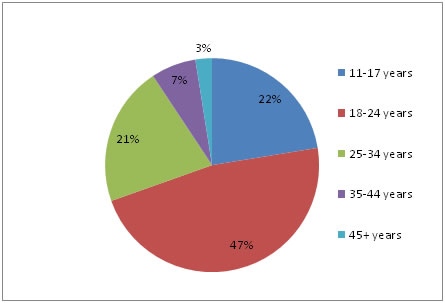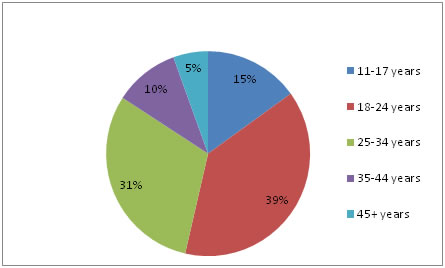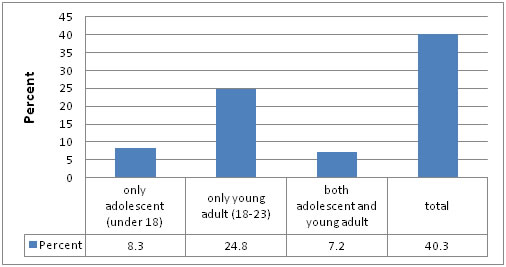Youth who receive special education services under the Individuals with Disabilities Education Act (IDEA 2004) and especially young adults of transition age, should be involved in planning for life after high school as early as possible and no later than age 16. Transition services should stem from the individual youth’s needs and strengths, ensuring that planning takes into account his or her interests, preferences, and desires for the future.
Prevalence of Teen Dating Violence
The reported incidence of teen dating violence varies significantly across studies, yet even with variation the known prevalence rates establish it as a serious problem in the United States. The different rates of prevalence may be a result of differences in the methodology, the definitions, and/or in the targeted population used in the studies.1 Some definitions of teen dating violence include incidences of all three types of relationship violence (physical, sexual, and emotional or psychological violence), while others focus on just one or two of those types of violence. Further, youth may be afraid to disclose violence to friends and family. According to one study, only a third of teens who were in an abusive relationship ever told anyone about the abuse they experienced.2
The 2010 National Intimate Partner and Sexual Violence Survey (NISVS), a national survey of intimate partner violence and sexual violence, collected reports of lifetime intimate partner violence from a random sample of women and men 18 and older. Figure 1 shows the age that women first reported experiencing intimate partner violence, for those women who had reported sexual violence including rape, physical violence, psychological violence, or stalking in their lifetime. Of these women, 69.5 percent reported experiencing intimate partner violence for the first time under the age of 24.3
Figure 1. Age at First Experience of Intimate Partner Violence for Women

Note: Intimate Partner Violence includes any form of physical violence, sexual violence, stalking, psychological aggression, and control of reproductive or sexual health. Respondents represent only those who reported experiencing intimate partner violence in their lifetime.
Figure 2 provides a similar graph for men who reported experiencing intimate partner violence in their lifetime. The survey indicated that, of those men, more than half had their first experience prior to age 24.4
Figure 2. Age at First Experience of Intimate Partner Violence for Men

Note: Intimate partner violence includes any form of physical violence, sexual violence, stalking, psychological aggression, and control of reproductive or sexual health. Respondents represent only those who reported experiencing intimate partner violence in their lifetime.
Physical Violence
- Rates of physical dating violence for youth have been found to range from 9 percent to 57 percent.5
- Nationally, according to the Youth Risk Behavior Surveillance System data, about ten percent of students report having been physically hurt by a boyfriend or girlfriend in the past 12 months.6 Across state-specific surveys the prevalence rates range from 7.4 percent to 17.8 percent with a median of 11.1 percent, and for local surveys the rates ranged from 8.0 percent to 18.5 percent with a median of 12.0 percent.7
- Figure 3 shows the increase in reported instances of physical and sexual partner violence from adolescence to young adulthood, as well as the persistence of violence for some youth.8
Figure 3. Percent of Responders Reporting Physical and Sexual Partner Violence Victimization in Three Waves of the National Longitudinal Study of Adolescent Health

Emotional Violence
- Rates of emotional and psychological abuse are far higher than physical violence for youth.9 Studies have found that as many as 76 percent of teens report emotional and psychological abuse during relationships.10
- According to analysis of the National Longitudinal Study of Adolescent Health, between 20 and 30 percent of youth reported being verbally or psychologically abused in the previous year. Specifically, 16 percent of youth age 12 to 21 have been insulted; 23 percent have been sworn at, and 4 percent have been threatened by a partner.11
Sexual Violence
- There is currently no nationally representative data on sexual dating violence specifically for youth. Smaller scale studies or studies focused on specific populations suggest that the rates of sexual violence tend to be lower than physical or psychological violence. Findings suggest that the prevalence of sexual violence ranges from 3 percent to 11 percent.12
- Recent research has found an overlap in reports of partner violence, pregnancy coercion, and birth control sabotage for young women. In addition they found links between these behaviors and unplanned pregnancies.13 Learn more about the relationship of gender and teen dating violence.
Resources
Youth Risk Behavior Survey 2007 - 2017
This data summary and trend report, from the Centers for Disease Control and Prevention's Division of Adolescent and School Health, has a section on violence victimization including information on trends related to dating violence among youth between the years 2007 to 2017.
The National Intimate Partner and Sexual Violence Survey (NISVS)
The CDC’s National Intimate Partner and Sexual Violence Survey (NISVS) is an ongoing, nationally-representative telephone survey that collects detailed information on sexual violence, stalking, and intimate partner violence victimization of adult women and men in the United States. The survey collects data on past-year experiences of violence as well as lifetime experiences of violence. The survey is also supported by the National Institute of Justice and the Department of Defense. A full report (PDF, 124 pages), summary in English (PDF, 8 pages) and Spanish (PDF, 8 pages), fact sheet (PDF, 2 pages), and a toolkit (PDF, 56 pages).
References
1 Offenhauer & Buchalter, 2011
2 Teenage Research Unlimited for Liz Claiborne Inc., 2005
3 Black et al., 2011
4 Black et al., 2011
5 O’Keefe, 2005
6 Centers for Disease Control and Prevention (CDC), 2010
7 CDC, 2010
8 Halpern, Spriggs, Martin, & Kupper, 2009
9 Offenhauer & Buchalter, 2011
10 Arriaga & Foshee, 2004
11 Halpern et al., 2001
12 Offenhauer & Buchalter, 2011
13 Miller et al., 2011
Other Resources on this Topic
Agencies
Announcements
Data Sources
Departments
Feature Articles
Hotlines
Programs
Publications
Resources
Technical Assistance
Tools & Guides
Videos & Podcasts
Websites
Youth Topics
Youth Briefs
Research links early leadership with increased self-efficacy and suggests that leadership can help youth to develop decision making and interpersonal skills that support successes in the workforce and adulthood. In addition, young leaders tend to be more involved in their communities, and have lower dropout rates than their peers. Youth leaders also show considerable benefits for their communities, providing valuable insight into the needs and interests of young people
Statistics reflecting the number of youth suffering from mental health, substance abuse, and co-occurring disorders highlight the necessity for schools, families, support staff, and communities to work together to develop targeted, coordinated, and comprehensive transition plans for young people with a history of mental health needs and/or substance abuse.
Nearly 30,000 youth aged out of foster care in Fiscal Year 2009, which represents nine percent of the young people involved in the foster care system that year. This transition can be challenging for youth, especially youth who have grown up in the child welfare system.
Research has demonstrated that as many as one in five children/youth have a diagnosable mental health disorder. Read about how coordination between public service agencies can improve treatment for these youth.
Civic engagement has the potential to empower young adults, increase their self-determination, and give them the skills and self-confidence they need to enter the workforce. Read about one youth’s experience in AmeriCorps National Civilian Community Corps (NCCC).






